|
From Deir Kamul on Mount Cudi to Deir al Surian in Egypt 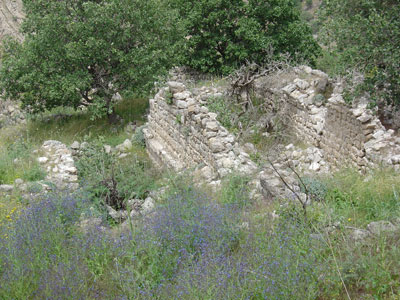 Ruins of Nestorian monastery Deir Kemol - Kamul on Mount Cudi, SE Turkey
One picture tells more than a thousand words. Is that really so? Please, look again at the picture above. What does it reveal besides high grasses, low trees and old weed-grown stones? Predominant green, lonesome grey and a touch of blue – colour spotted blindness, a fragment of an arbitrary mountainous landscape. The picture gets its real content from the few words of the caption underneath and its true story from the thousand words that are needed to clarify it.
The British female explorer Gertrude Bell travelled through the Middle East at the end of the 19th and the beginning of the 20th century. She was in search of what was left of the age-old Christian architecture in Mesopotamia. She took pictures of ruined churches and monasteries and commented on her travel experiences in her diaries and letters. In the spring of 1909 she reached Mount Cudi, nowadays a mountain range in the southeastern border region of Turkey. She was cordially welcomed by Qasha Mattai, the priest of the Christian village of Hassana in the southern foothills of Mount Cudi, on whose top according to local Christian and Islamic tradition Noah’s Ark had landed after the Flood. It was a holy place for the oriental Christians in that region and in the early ages of Christianity pious hermits had settled on the upper slopes of Mount Cudi. What was left of the hermitages and monasteries they had built there? Very early in the morning of May 12, 1909, Gertrude Bell with priest Mattai and his brother Shimun started from the village of Hassana and went up the mountain. Afterwards she noted down a detailed description of the trip in her diary:
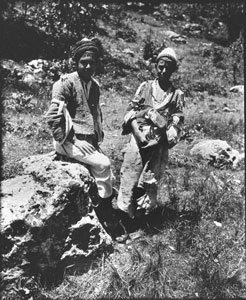 Assyrian mountain gnomes (G Bell)
What is clearly visible on the first picture that illustrates this text, is precisely what Gertrude Bell must have seen, though the colour picture is taken almost a century later. This happened during a sneaky climb up the mountain in June 2004. By then the Assyrian Christian villagers, descendants of priest Mattai, had already left Hassana. They were evicted from their native village by the Turkish army in 1993 and since then the place has been off limits, with Turkish military controlling the whole Cudi area in order to prevent infiltrations of Kurdish PKK-fighters. The site of the ruined monastery with the vaulted chambers as described by Gertrude Bell, was called Ukmel in Sureth, the Neo Aramaic idiom of the people of Hassana. According to them there were natural water basins nearby and the villagers used to dig for gold on the site, because they thought that great treasures were hidden there. It was wishful thinking. The only treasure on the site is the historical value of that ruined monastery.
The old name of the monastery is Deir Kemol or Kamul. It is mentioned in the hours of daily prayers, the Daily Offices, of the East Syriac rite, which is used by the Assyrian Church of the East and the Chaldean Church. In a hymn – motwa in Syriac – for Wednesdays at the Night Service we find the following passage:
Raban Joseph the Seer,
Whose monastery is in the Kurdish mountain,
Saw exalted revelations
Above the nature of man
And the great habitation near thereby
Called Kmul, the fountain of love,
Hath the fame of the Paradise of Eden.
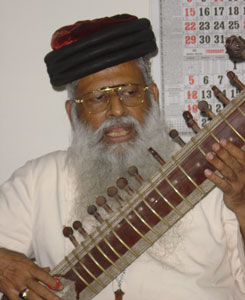 Metropolitan Aprem - Trichur, India
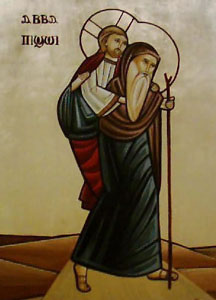 Saint Bishoi - Egyptian hermit
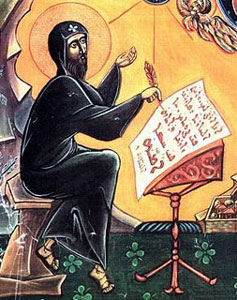 Mor Ephrem the Syrian
In the 6th century the doctrine of bishop Julian of Halicarnassos (Bodrum) spread throughout Egypt, when Julian was exiled and came to Alexandria. He preached that the body of Christ was not a normal human body of flesh and blood – it was inseparably united with God and therefore not susceptible to decay or corruption. This extreme monophisitism, focusing on the divine nature of Christ, was rejected as heresy by the Orthodox Church in Egypt, since bishop Julian’s doctrine denied the orthodox belief that the Holy Virgin Maria was the Mother of God or Theotokos, who gave birth to Christ. In the monastic communities at Wadi Natrun many monks accepted the doctrine of bishop Julian. Those who rejected this doctrine and remained within the mainstream Coptic and Syriac Orthodox Church founded new monasteries in the neighbourhood of the original ones. Close to Saint Bishoi Monastery a twin monastery was thus established. It took the name Monastery of the Holy Virgin Theotokos. In the 8th century Syrian merchants from Mesopotamia settled down in Old Cairo. They bought the Monastery of the Holy Virgin Theotokos close to the old Saint Bishoi Monastery and gave it to Syrian monks. Those Syrian monks renamed it the Monastery of the Mother of God of the Syrians and so it became known as Deir al-Surian: the Monastery of the Syrians.
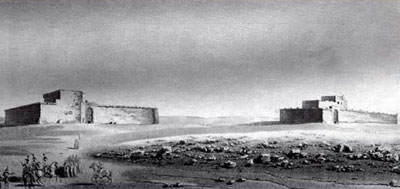 Wadi Natrun 1809 - twin monasteries Deir Anba Bishoi and Deir al-Surian
In the year 927 Moses of Nisibis, abbot at Deir al-Surian, travelled to Mesopotamia in search of manuscripts. Three years later he returned to Egypt with 250 precious Syriac manuscripts, thus laying the foundations of the famous Deir al-Surian library. For centuries that library was situated on the second floor of the monastery tower. At the beginning of the 18th century the Lebanese orientalists Elias and Joseph Simon Assemani were sent to Egypt as papal envoys. They visited Deir al-Surian and got hold of 40 Syriac manuscripts, which till today are preserved in the Vatican Library in Rome. Lord Curzon came to the monastery in 1837. In his work Monasteries of the Levant he describes how he plied the old and blind abbot with Italian liquor and got access to an oil-cellar where unique Syriac manuscripts were wasting away. He bought them -very British - at a ridiculous price. Lord Curzon was not the only treasure hunter in those days. In the 19th century Western visitors to the monastery obtained 500 manuscripts for the British Museum in London. In many cases these Syriac manuscripts are the oldest copies of Greek classical texts from Aristoteles, Archimedes, Hippocrates and others, which were until that time only known to European scholars in corrupt medieval Latin translations.
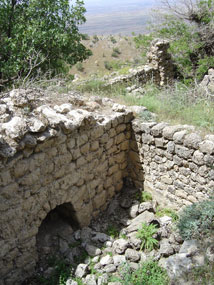 Deir Kemol - June 2004
Text & (Deir Kemol - Metropolitan Aprem) illustrations - A Thiry
|

 Homeland
Homeland  Turkey
Turkey  Silopi Region
Silopi Region  From Mount Cudi to Egypt
From Mount Cudi to Egypt

 Homeland
Homeland  Turkey
Turkey  Silopi Region
Silopi Region  From Mount Cudi to Egypt
From Mount Cudi to Egypt